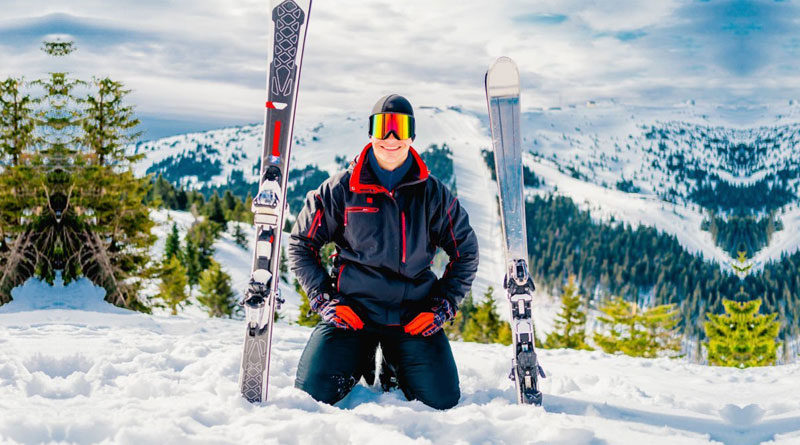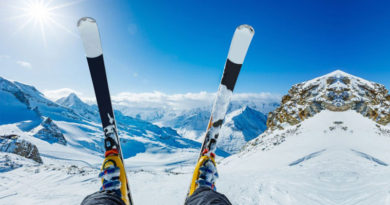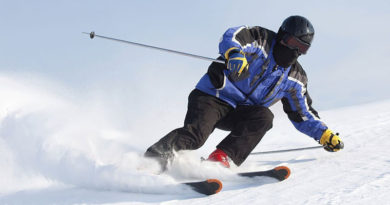How Should a Ski Jacket Fit?
A well-fitted ski jacket is essential for a successful day in the mountains. The function of your jacket is to keep you warm and protect you against the elements. If your jacket doesn’t fit you well, you will stay uncomfortable throughout the day and won’t get protection on the slopes. So it’s vital to get the right fit out of your jacket. Ski jacket comes in various fit and sizes and you need to figure out your correct size. If you don’t know your exact size, it’s recommended to try the jacket before buying. And with your jacket on, you should be able to wear your base-layer and mid-layer comfortably. At the same time, it shouldn’t feel too loose.
Below I have described the fit of a ski jacket in-depth. So keep reading for more information.
The Overall Fit

Unlike snowboard jackets, ski jackets are designed to be a little tight to achieve maximum speed on the slopes. Snowboard jackets, on the other hand, are designed to be a little baggy so you can perform tricks easily. However, a ski jacket that is too tight can restrict your freedom and movement and can also make you uncomfortable. So, your jacket should neither be too tight nor too loose. It should provide a happy medium snug fit for a comfortable ride. A tight jacket restricts your movement when you are performing tricks. It also limits the mid and base-layer choices that you wear under your jacket. Additionally, it is advisable to choose your usual size. You don’t need to size up in ski jackets.
If you opt for a baggy ski jacket, it will not keep you warm and comfortable. Also, you will not get protection against the snow, which results in the snow getting into your jacket, especially when performing tricks. This is important because when you perform tricks, there’s a high chance that snow can enter your jacket leaving you cold and uncomfortable. A jacket that doesn’t fit you feel can be very uncomfortable. It can be hard to ski in this kind of jacket. Finally, a loose-fitting jacket may not give you good compatibility with ski pants. Because pants and jackets attach to better protect you from cold and snow.
Layering
Whether you are skiing or snowboarding, wearing clothes in layers is essential to stay warm and dry. Your ski jacket should provide enough room underneath so you can wear your base layer and mid-layer comfortably. With the mid and base layer on, your jacket may feel even tighter. So make sure you get that happy snug fit with your layers on. You can also customize how warm you are going to be for the temperature that day by adding or removing layers. If you are planning to ski in super cold conditions, it’s advisable to get a jacket with some built-in insulation. This insulation along with the mid layer will keep you warm even in the coldest of temperatures.
A base layer (aka underwear) is the first layer that you wear and it’s the layer that touches your skin. The function of a base layer is to keep you dry by wicking sweat. The base layer is supposed to fit next to the skin so that it can wick as much moisture as it can. On hotter days, you can choose to wear a loose-fitting base layer to enjoy more air circulation but it won’t wick moisture effectively. Learn more about choosing a base layer here.
The next layer that you have to accommodate underneath your jacket is the mid-layer. This is the layer that traps body heat and keeps you warm. You can choose to have a lightweight fleece underneath your jacket because it’s breathable and dries out faster. Other than fleece, there are two more insulation options available; i.e. down and synthetic. Both insulations have their pros and cons. Learn more about down vs. synthetic insulation here.
Sleeves
Choose a jacket with sleeves long enough to cover over your ski gloves or mittens. It is essential to have a little bit of length in the sleeves so that it can over the space between where your mittens end and your sleeves begin. It is important because you don’t want your sleeves to ride up while skiing. Also, if your gloves are tucked properly in the sleeves, it will keep the snow and cold air out. It is also important to note that the sleeves shouldn’t be too long either. If your sleeves are running down to the tips, it means that the sleeves are a little too long and you need to size down.
Length
Ski jackets come in three different length options; waist-length, hip length, and thigh length. However, the length of your jacket can also be a preference thing. A good rule of thumb is to get a jacket that sits between your waist and hip. This is the length that works in most situations. Some people choose longer lengths because they look cool and provide extra protection from the snow. This is a good idea because when you sit on a chairlift, these thigh-length ski jackets keep the snow out and protect you from the cold surface. Finally, make sure the powder skirt of your jacket is also compatible with your ski pants. This will make sure you are completely protected against the snow.
Hood
The fit of the hood is also an important thing. Your jacket should have a hood big enough to accommodate your head with a ski helmet on. This is because you will also be wearing your hood on those slow chairlift rides on windy days. So, it is always a good idea to test your hood with the helmet on. This test will ensure that the helmet is perfectly accommodated with all zipped up while still feeling comfortable for longer use. If the hood doesn’t fit well, it will be easily blown off of your helmet and this can be a very uncomfortable experience.
Conclusion
The purpose of your ski jacket is to keep you warm and dry in the mountains. If your jacket doesn’t fit you well, it won’t be able to perform these functions resulting in a miserable experience. Unlike snowboard jackets, ski jackets are designed to be a little tight for achieving maximum speed. But that doesn’t mean it should restrict your movement. Your jacket should also allow enough room underneath so you can wear layers comfortably. The sleeves of your jacket are supposed to cover over your gloves to seal out snow. When it comes to length, your jacket should sit between your waist and hips, which is the ideal length. Finally, the hood should be big enough to accommodate your helmet.




